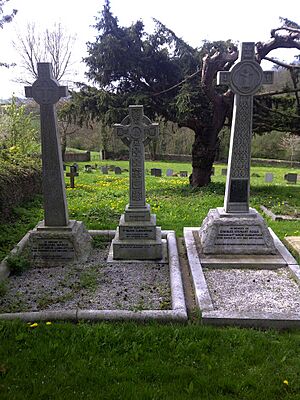St Cadoc's Church, Llangattock Vibon Avel facts for kids
Quick facts for kids St Cadoc's Church, Llangattock Vibon Avel |
|
|---|---|
| Church of St Cadoc | |

"a fine High Victorian rural church"
|
|
| Lua error in Module:Location_map at line 420: attempt to index field 'wikibase' (a nil value). | |
| Location | Llangattock Vibon Avel, Monmouthshire |
| Country | Wales |
| Denomination | Church in Wales |
| History | |
| Status | Parish church |
| Founded | c.14th century |
| Architecture | |
| Functional status | Redundant |
| Heritage designation | Grade II* |
| Designated | 27 November 1953 |
| Architectural type | Church |
The Church of St Cadoc is a historic church located in Llangattock Vibon Avel, Monmouthshire, Wales. It was first built a very long time ago, in the Middle Ages, but was greatly repaired and updated in the 1800s. This church was once part of a large estate called The Hendre and has strong ties to the famous Rolls family. You might know them from Rolls-Royce cars! The grave of Charles Stewart Rolls, who was a pioneer in cars and airplanes, is in the churchyard. Today, the church is a special Grade II* listed building, meaning it's very important. It is now looked after by a group called the Friends of Friendless Churches.
Contents
History of St Cadoc's Church
The church is named after Saint Cadoc, a Welsh saint. It was originally built in the medieval period. Old documents from the Middle Ages describe this church as a clas. This means it was a main church that served several smaller churches nearby. It had a community of priests working there.
The very first church was likely made from wood and mud. Later, it was rebuilt using stone. The porch tower is the only part left from that original stone church. Experts believe the door of the tower was built around the year 1300.
The Rolls Family Connection
In the 1800s, St Cadoc's Church became the private church for the Rolls family. They lived at a large estate called The Hendre. The church was extensively repaired and updated during their time. John Etherington Welch Rolls first started the renovations. Later, his son, John Rolls, 1st Baron Llangattock, continued the work. Both times, the architect in charge was Thomas Henry Wyatt.
Between these two big renovation projects, the inside of the church was beautifully decorated. John Maclean, the eldest son of Lord Llangattock, inherited his father's title in 1912. Sadly, he was killed in 1916, and the family title ended with him.
Charles Rolls' Grave
Charles Stewart Rolls, who was John Maclean's younger brother, is buried in the churchyard. Charles Rolls was very famous for co-founding Rolls-Royce Limited. He died in a plane crash in 1910, before his brother. His grave is next to his mother and father.
The church remained connected to The Hendre estate until the 1980s, when the estate was sold. St Cadoc's Church continued to be an active local church until December 2020. At that time, it was given to the Friends of Friendless Churches charity. This group helps to protect and care for old churches that are no longer used for regular services.
Architecture and Design
Most of St Cadoc's Church was rebuilt in the 1800s. Only the porch tower, which dates back to the 1400s, remains from the earlier stone church. The first major rebuilding happened in 1852–1853. The second one took place in 1875. During these projects, the main part of the church, called the nave, and the chancel (the area around the altar) were built.
The church is made from a type of stone called old red sandstone. Its roof is covered with red clay tiles. Inside the church, you can see beautiful stained glass windows. These were created by an artist named Charles Eamer Kempe.
The church is a Grade II* listed building. This means it is considered very important because of its history and design. The listing describes it as "a fine High Victorian rural church with a good interior." It is also noted for its special connection to the Rolls family of The Hendre.


